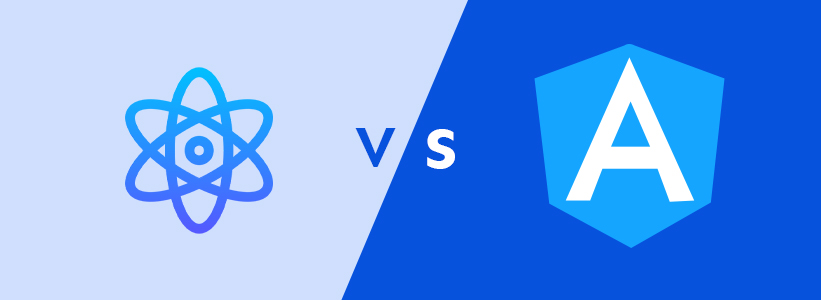ReactJS vs AngularJS choosing the right framework for your next web app

If you looking to build your website or web application with the latest modern web development frameworks, you might be wondering whether you should go for ReactJS or AngularJS. Well, this blog will save time and help you decide which framework is best for your next app. Stay along!
A framework may make all the difference when it comes to app or web development. There are several popular JavaScript frameworks available, and two of the most popular are ReactJS and AngularJS. They both offer powerful tools and resources for creating dynamic, high-performance applications.
We’ll explore the development approach of each framework, including the differences in their architecture and the learning curve involved. We’ll also delve into the performance of React and Angular, looking at how they handle large-scale applications.
We’ll first cover the most-common question- why one should choose JavaScript for app development, then deep dive into RactJS vs Angular. At the end of this blog, you’ll know how to determine which framework is best for your requirements. This comparison of ReactJS vs Angular will help you make an informed decision whether you’re developing a small personal project or a large enterprise application.
Why Choose JavaScript Framework for App or Web Development?
JavaScript frameworks are popular among developers for several reasons, including:
- Simplified Development:JavaScript frameworks offer pre-built tools and libraries that simplify and speed up the development process. This enables developers to concentrate on the application logic rather than the technical specifics.
- Code Reusability: JavaScript frameworks enable developers to reuse code across different projects, reducing development time and effort. This also provides uniformity throughout the system, making maintenance and updating easy.
- Consistent Performance: JavaScript frameworks are designed to handle complex applications, ensuring consistent performance across different devices and platforms.
- Improved User Experience: JavaScript frameworks provide a wide range of pre-built components and features, allowing developers to create a more engaging and interactive user experience.
- Community Support: Most JavaScript frameworks have a big and active developer community, so developers may rapidly locate assistance and resources.
- Cross-Platform Compatibility: Applications that function on Computers, mobile devices, and browsers can all be created using JavaScript frameworks.
- Scalability: JavaScript frameworks are designed to handle large-scale applications, allowing developers to scale the application as the business grows.
Some popular JavaScript frameworks include React, Angular, Vue, and Ember. These frameworks are frequently used by Angularjs developers for hire to create intricate web applications and to facilitate the development process. Using a JavaScript framework can help businesses save time and effort, improve application performance, and deliver a better user experience.
Who Needs to Use a JavaScript Framework?

JavaScript frameworks are used by top JavaScript development company and developers who build complex web applications or websites that require a lot of interactivity, dynamic content, and real-time data updates.
- To build single-page applications (SPAs) that require complex user interfaces and real-time data updates.
- To build e-commerce websites with advanced filtering, sorting, and search capabilities.
- To build web-based games and simulations that require fast and smooth user interactions.
- To build real-time collaboration and communication tools like chat applications, video conferencing software, and collaborative editing tools.
- To work on large-scale web projects that require code organization, maintainability, and scalability.
- To build web applications that require to be accessible and responsive on multiple devices and screen sizes.
Overall, JavaScript frameworks can help developers create more efficient, maintainable, and scalable web applications, and are particularly useful for projects that require a lot of interactivity, real-time data updates, and complex user interfaces.
Now that we know why you should use JavaScript, it’s time to dive into ReactJS vs Angular!
ReactJS: An Overview
Facebook developed the JavaScript library known as ReactJS, or just React. Since its first release in 2013, it has grown to be one of the most widely used JavaScript frameworks for developing web apps. Because React is a declarative, component-based toolkit, it places a strong emphasis on creating reusable user interface (UI) components that can be quickly combined to create intricate user interfaces.
React is well-known for being simple to use, which makes it a great option for developing small to medium-sized online apps. React’s success can be attributed to its capacity to produce responsive and dynamic user interfaces while giving programmers a strong set of tools for developing sophisticated applications.
Pros and Cons of ReactJS:
Pros:
- Fast and Efficient:ReactJS’s virtual DOM and one-way data flow make it efficient at rendering and updating components, leading to faster performance and better user experience.
- Component-Based Architecture:ReactJS’s component-based architecture makes it easy to break down large and complex user interfaces into smaller and more manageable pieces, improving maintainability and reusability.
- Large and Active Community:There is a sizable and active community for ReactJS, and there are many tools and libraries from third parties as well as a plethora of resources and support.
- Flexibility and Customization:ReactJS’s simple and lightweight design makes it easy to integrate with other libraries and tools, providing more flexibility and customization options.
Cons:
- Steep Learning Curve:ReactJS has a steep learning curve, particularly for developers who are new to the JavaScript ecosystem. Although React has a moderate learning curve when comparing React with Angular.
- JSX Syntax:ReactJS’s use of JSX syntax can be a barrier for developers who are more comfortable with traditional HTML and CSS.
- Lack of Built-In Features:ReactJS is a library, not a full-fledged framework, which means it lacks some of the built-in features that are available in other frameworks like Angular.
Angular: An Overview
Angular is a JavaScript framework developed by Google. It was initially made available in 2010 as AngularJS, then in 2016 it underwent a rewrite to become Angular. Angular is a full-featured framework, which means it provides everything you need to build large-scale web applications, including data binding, routing, and dependency injection.
Angular is known for its robustness and the amount of functionality it provides out of the box. It is a great choice for building large, complex applications that require features such as data binding, routing, and testing. However, because of its complexity, it can take longer to learn and be more challenging to work with than React.
Pros and Cons of Angular:
Pros:
- Comprehensive Features:Angular provides a range of built-in features, such as routing, forms, and animations, which can save development time and improve the user experience.
- Two-Way Data Binding:Angular’s two-way data binding can simplify data management and reduce development time for applications that require frequent and complex data interactions.
- Modular and Scalable Architecture:Angular’s modular and scalable architecture makes it easy to maintain and update large web applications over time, reducing technical debt and improving performance.
Cons:
- Steep Learning Curve:For developers who are unfamiliar with the technology, Angular has a more difficult learning curve than ReactJS.
- Larger Overhead:Angular may have a larger overhead compared to ReactJS, making it less suitable for smaller and simpler projects.
- Less Flexible: p>Angular’s opinionated structure and syntax can be less flexible and customizable than ReactJS.
ReactJS vs Angular: The Ultimate Showdown:

Now that we have introduced ReactJS and Angular, let’s compare the two frameworks in more detail.
Architecture:
ReactJS is a library, while Angular is a full-featured framework. This means that React focuses on building reusable UI components, while Angular provides a complete set of tools for building large, complex applications. React’s simplicity makes it easier to learn and more flexible than Angular, while Angular’s comprehensive approach makes it a more powerful framework for building large-scale applications. Angular is a complete framework that provides tools for building UI components, handling routing, managing data, and more.
Performance:
ReactJS has a lightweight and simple design that allows for fast rendering and updating of components. The framework’s virtual DOM and one-way data flow help minimize unnecessary updates and improve performance. ReactJS also provides a set of performance optimization tools, such as React. memo and React. lazy, which can help reduce rendering time and improve overall application performance.
Angular’s more comprehensive architecture provides built-in tools and features for optimizing performance. The framework’s two-way data binding and change detection system can help reduce the amount of code required to update the UI, improving performance. Angular also has a built-in AOT (Ahead-Of-Time) compilation feature that can help improve the initial load time of the application.
In general, ReactJS is known for its fast rendering and updating of components, while Angular is known for its efficient change detection system and built-in optimization tools. In the end, the effectiveness of both frameworks will rely on the expertise of the developers. If you want to create a robust and efficient app, you should hire a team of developers from the best app and web development companies like Imenso Software.
Scalability:
When it comes to scalability, both frameworks have their strengths and weaknesses.
ReactJS has a modular and flexible architecture that allows developers to scale their applications incrementally. It is simple to split complicated applications into smaller, more manageable chunks because of the framework’s component-based architecture. This approach also allows ReactJS developers to optimize the performance of specific components without affecting the rest of the application.
Angular has a more structured and comprehensive architecture that provides a more organized approach to scaling applications. Large quantities of data and components can be managed more easily because of the framework’s two-way data binding and dependency injection capabilities. Angular’s component hierarchy also allows for efficient code organization and reuse. Furthermore, Angular has a powerful CLI (Command Line Interface) tool that can automate many development tasks and improve scalability.
Learning Curve:
React has a relatively easy learning curve compared to Angular. It has a minimalistic approach and focuses only on the View layer of the application. React relies heavily on JavaScript and its syntax, which is easy to understand for most programmers. Additionally, React has a vast ecosystem of libraries and tools that make development easier and faster.
Angular, on the other hand, has a steeper learning curve compared to React. It has a lot of features and concepts that need to be understood, such as dependency injection, directives, and services. Angular also has a large codebase, and developers need to be familiar with TypeScript and HTML in addition to JavaScript. However, once you understand the concepts, Angular can be a powerful tool for building complex web applications.
Development Approach:
ReactJS and Angular have different approaches to web development. ReactJS uses a component-based approach, where developers create individual components that can be reused across different parts of the application. These components are responsible for rendering specific parts of the UI and can be combined to create more complex UIs.
Angular uses a template-based approach, where developers create templates that are then populated with data. Angular also has a more comprehensive architecture that provides tools for building UI components, handling routing, managing data, and more.
Community Support:
Both ReactJS and Angular have large and active communities that provide plenty of resources and support for developers. ReactJS has a larger community with more available libraries and tools. The ReactJS community is constantly developing new tools and features, making it easier for developers to build complex web applications. Also, ReactJS developers have access to a plethora of online resources, including documentation, tutorials, and forums. Like ReactJS, Angular has a sizable community as well.
The Angular community is known for its focus on quality and providing robust solutions to complex problems. The community provides resources, such as documentation, blogs, and forums, to help businesses build scalable applications.
Tooling and Ecosystem:
ReactJS has a vast ecosystem of tools and libraries, including Redux, React Native, and Next.js. This makes it easy to integrate with other libraries and tools and build complex applications quickly. Angular also has a large ecosystem of tools and libraries, including Angular Material, RxJS, and Ionic. However, its comprehensive approach can make it more challenging to integrate with other tools and libraries.
When to Choose ReactJS?
ReactJS is an excellent choice for building dynamic and interactive user interfaces, especially for web applications that require frequent updates and changes. Here are some situations where ReactJS would be a good choice:
- Large and Complex UI:If the web application has a large and complex UI, ReactJS’s component-based architecture can help break it down into smaller, more manageable pieces.
- Fast Performance:ReactJS’s virtual DOM and one-way data flow make it efficient at rendering and updating components, leading to faster performance and better user experience.
- High Developer Productivity:ReactJS’s lightweight and simple design, along with its large and active community, makes it easy for developers to learn and use, improving productivity and reducing Angularjs development time.
- Integration with Other Libraries:ReactJS’s simple design makes integrating with other libraries and tools easy, providing more flexibility and customization options.
Overall, ReactJS is a good choice for building scalable and flexible web applications with dynamic user interfaces.
When to Choose Angular?
Here are some scenarios where choosing Angular may be a good choice:
- Large-Scale Projects:Angular provides a robust architecture and a set of tools to build complex, large-scale applications that require a lot of structure and maintainability.
- Single-Page Applications (SPAs):Angular is designed to build SPAs with a powerful two-way data binding system, routing, and dependency injection.
- Enterprise-Level Applications:Angular’s strong TypeScript-based framework allows for better organization and scalability of code, making it a great choice for enterprise-level applications.
- Reactive Programming:Angular makes use of RxJS, which allows for reactive programmings, such as event-based programming or data streams.
- Full-Stack Development:Angular can be used in conjunction with other back-end frameworks, such as Node.js or ASP.NET, to create full-stack applications.
Overall, Angular is a good choice for building large and complex web applications that require extensive functionality, maintainability, and scalability.
Wrapping it Up:
It’s difficult to definitively declare one framework better than the other, as both ReactJS and Angular have their strengths and weaknesses.
In terms of popularity, ReactJS currently has a larger market share and a larger community of developers. It’s known for its fast and efficient performance, component-based architecture, and flexibility. However, it may have a steeper learning curve and require more overhead for smaller projects.
On the other hand, Angular is known for its comprehensive features, two-way data binding, and modular architecture. It may be a better choice for larger and more complex projects, but can also have a steeper learning curve and be less flexible than ReactJS.
Ultimately, the choice between ReactJS and Angular will depend on the specific needs and requirements of the project. Businesses should carefully consider factors such as project size, complexity, scalability, and team expertise when making a decision. You can also contact the team of experts at Imenso Software to get a free estimate on your next project.
We’re honored to mention that our efforts have been recognized by renowned B2B review and research platforms such as GoodFirms, Clutch, MirrorView, and many more.
Similar Posts

How Artificial Intelligence is Revolutionizing Social Media to Drive Higher Engagement
Have you ever wondered how social media platforms seem to know exactly what content you want to see, even before you do? Or how they manage to keep you endlessly scrolling through your feed, mesmerized by a stream of captivating posts and videos? The answer lies in the powerful integration of Artificial Intelligence (AI) into […]...

Node.js Microservices: A Guide to Building Scalable Apps
Are you ready to unlock the secrets to building agile, scalable applications that cater to the dynamic needs of today’s users? As technology continues to advance, businesses are faced with the daunting task of meeting ever-growing demands while maintaining efficiency and reliability. In this era of constant innovation, microservices architecture has emerged as a game-changer, […]...

Effective Ways Offshore Software Development Companies Improve Business Security
Software development companies have grown sporadically over the years, likewise the villain teams of expert hackers who work around the clock trying to infiltrate processes. That leads to the implementation of extra measures on already existing security processes in the software development world. ...










